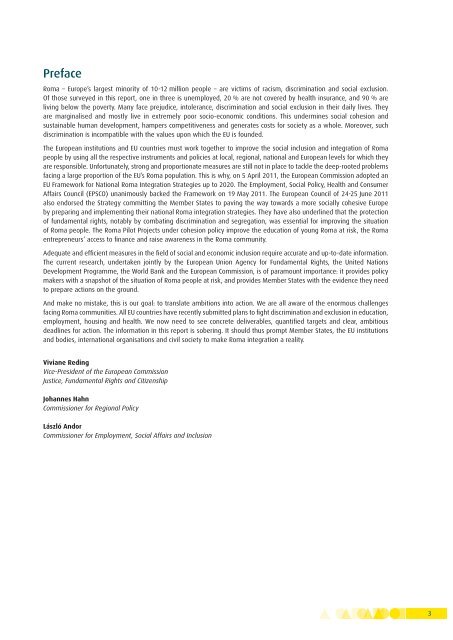The situation of Roma in 11 EU Member States - European Union ...
The situation of Roma in 11 EU Member States - European Union ...
The situation of Roma in 11 EU Member States - European Union ...
You also want an ePaper? Increase the reach of your titles
YUMPU automatically turns print PDFs into web optimized ePapers that Google loves.
Preface<br />
<strong>Roma</strong> – Europe’s largest m<strong>in</strong>ority <strong>of</strong> 10-12 million people – are victims <strong>of</strong> racism, discrim<strong>in</strong>ation and social exclusion.<br />
Of those surveyed <strong>in</strong> this report, one <strong>in</strong> three is unemployed, 20 % are not covered by health <strong>in</strong>surance, and 90 % are<br />
liv<strong>in</strong>g below the poverty. Many face prejudice, <strong>in</strong>tolerance, discrim<strong>in</strong>ation and social exclusion <strong>in</strong> their daily lives. <strong>The</strong>y<br />
are marg<strong>in</strong>alised and mostly live <strong>in</strong> extremely poor socio-economic conditions. This underm<strong>in</strong>es social cohesion and<br />
susta<strong>in</strong>able human development, hampers competitiveness and generates costs for society as a whole. Moreover, such<br />
discrim<strong>in</strong>ation is <strong>in</strong>compatible with the values upon which the <strong>EU</strong> is founded.<br />
<strong>The</strong> <strong>European</strong> <strong>in</strong>stitutions and <strong>EU</strong> countries must work together to improve the social <strong>in</strong>clusion and <strong>in</strong>tegration <strong>of</strong> <strong>Roma</strong><br />
people by us<strong>in</strong>g all the respective <strong>in</strong>struments and policies at local, regional, national and <strong>European</strong> levels for which they<br />
are responsible. Unfortunately, strong and proportionate measures are still not <strong>in</strong> place to tackle the deep-rooted problems<br />
fac<strong>in</strong>g a large proportion <strong>of</strong> the <strong>EU</strong>’s <strong>Roma</strong> population. This is why, on 5 April 20<strong>11</strong>, the <strong>European</strong> Commission adopted an<br />
<strong>EU</strong> Framework for National <strong>Roma</strong> Integration Strategies up to 2020. <strong>The</strong> Employment, Social Policy, Health and Consumer<br />
Affairs Council (EPSCO) unanimously backed the Framework on 19 May 20<strong>11</strong>. <strong>The</strong> <strong>European</strong> Council <strong>of</strong> 24-25 June 20<strong>11</strong><br />
also endorsed the Strategy committ<strong>in</strong>g the <strong>Member</strong> <strong>States</strong> to pav<strong>in</strong>g the way towards a more socially cohesive Europe<br />
by prepar<strong>in</strong>g and implement<strong>in</strong>g their national <strong>Roma</strong> <strong>in</strong>tegration strategies. <strong>The</strong>y have also underl<strong>in</strong>ed that the protection<br />
<strong>of</strong> fundamental rights, notably by combat<strong>in</strong>g discrim<strong>in</strong>ation and segregation, was essential for improv<strong>in</strong>g the <strong>situation</strong><br />
<strong>of</strong> <strong>Roma</strong> people. <strong>The</strong> <strong>Roma</strong> Pilot Projects under cohesion policy improve the education <strong>of</strong> young <strong>Roma</strong> at risk, the <strong>Roma</strong><br />
entrepreneurs‘ access to f<strong>in</strong>ance and raise awareness <strong>in</strong> the <strong>Roma</strong> community.<br />
Adequate and efficient measures <strong>in</strong> the field <strong>of</strong> social and economic <strong>in</strong>clusion require accurate and up-to-date <strong>in</strong>formation.<br />
<strong>The</strong> current research, undertaken jo<strong>in</strong>tly by the <strong>European</strong> <strong>Union</strong> Agency for Fundamental Rights, the United Nations<br />
Development Programme, the World Bank and the <strong>European</strong> Commission, is <strong>of</strong> paramount importance: it provides policy<br />
makers with a snapshot <strong>of</strong> the <strong>situation</strong> <strong>of</strong> <strong>Roma</strong> people at risk, and provides <strong>Member</strong> <strong>States</strong> with the evidence they need<br />
to prepare actions on the ground.<br />
And make no mistake, this is our goal: to translate ambitions <strong>in</strong>to action. We are all aware <strong>of</strong> the enormous challenges<br />
fac<strong>in</strong>g <strong>Roma</strong> communities. All <strong>EU</strong> countries have recently submitted plans to fight discrim<strong>in</strong>ation and exclusion <strong>in</strong> education,<br />
employment, hous<strong>in</strong>g and health. We now need to see concrete deliverables, quantified targets and clear, ambitious<br />
deadl<strong>in</strong>es for action. <strong>The</strong> <strong>in</strong>formation <strong>in</strong> this report is sober<strong>in</strong>g. It should thus prompt <strong>Member</strong> <strong>States</strong>, the <strong>EU</strong> <strong>in</strong>stitutions<br />
and bodies, <strong>in</strong>ternational organisations and civil society to make <strong>Roma</strong> <strong>in</strong>tegration a reality.<br />
Viviane Red<strong>in</strong>g<br />
Vice-President <strong>of</strong> the <strong>European</strong> Commission<br />
Justice, Fundamental Rights and Citizenship<br />
Johannes Hahn<br />
Commissioner for Regional Policy<br />
László Andor<br />
Commissioner for Employment, Social Affairs and Inclusion<br />
3


